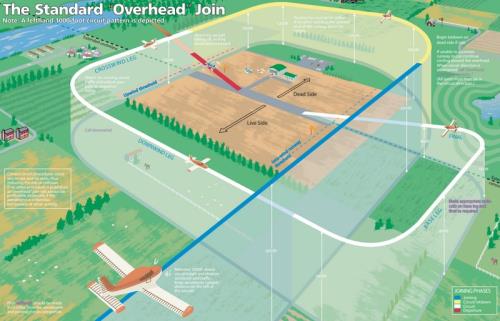Whatever opinion is held about it, I would hope that everyone could agree the UK CAA prescribes something called a Standard Overhead Join. I have already posted two illustrations of this from CAA publications, and here is a third from one of their safety posters at
https://publicapps.caa.co.uk/docs/33/ga_srgwebStandardOverheadJoinPosterJan09.pdf
Note the initial blue line in the diagram, and the key bottom right. The blue line is defined as the “joining phase”. The starting point of the joining phase is
always on the live side, and it
always continues towards the dead side. It does not matter a jot from which point of the compass the aircraft is arriving – the ideal (CAA prescribed) starting point for the overhead join is
always in the same place for a given runway and direction. If an aircraft joins somewhere else it is not a “standard overhead join”.
The descent phase (yellow line) is on the dead side. Turn left and descend to enter a left hand circuit on the crosswind leg. Turn right and descend to enter a right hand circuit on the crosswind leg. The key point is
you are by then no longer “joining” – you have already done that (the blue line). That’s not my opinion, it’s what the CAA prescribes. I cannot see how anyone can argue any of the above as the CAA makes it all absolutely clear.
The SD arrival function knows the runway in use (the user selects this). Therefore it
could very helpfully depict the ideal place and direction to “join overhead”, which would be the same
whatever direction the join is from. It's then up to the pilot to arrive there pointing the right way, but at least she knows where she's heading for. For me the best way to represent this would be a big fat purple arrow, with – optionally – its pointed end turned in the circuit direction. Very similar to what SD depicts at the moment, but (correctly) pointing from live side to dead side.
There are several reasons I am labouring this issue. For me, working out the orientation to join overhead (in the prescribed CAA manner) on receiving runway information is quite taxing in an already high workload phase of flight. SD is generally of enormous help to me but lets me down on this one point.
Despite the rationale given for it being correct (such as “the purple arrow shows your
entry into the circuit [Ed: therefore at circuit height, way below joining height] from
after you have joined overhead and descended dead side”), which may or may not be true, it is
not correct “
guidance on where to join” (SD tutorial) for a Standard Overhead Join. I like SD to be accurate.
Finally, it seems to me that it’s a simple thing to correct – or ‘improve’ if you prefer. The purple arrows for the other types of join (Downwind, Downwind 45, Base, Long Final) are all spot-on! All the info is there so why not make the Standard Overhead join correct as well? It was said it can't be done because the direction the aircraft is coming from is not know. As explained above -
the direction does not matter! The arrows are drawn correctly for the other four types of join despite also not knowing the arrival direction.